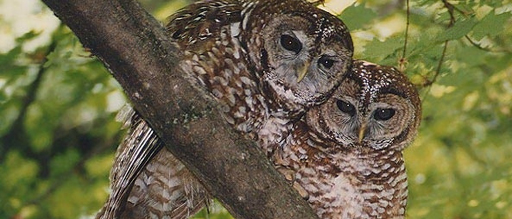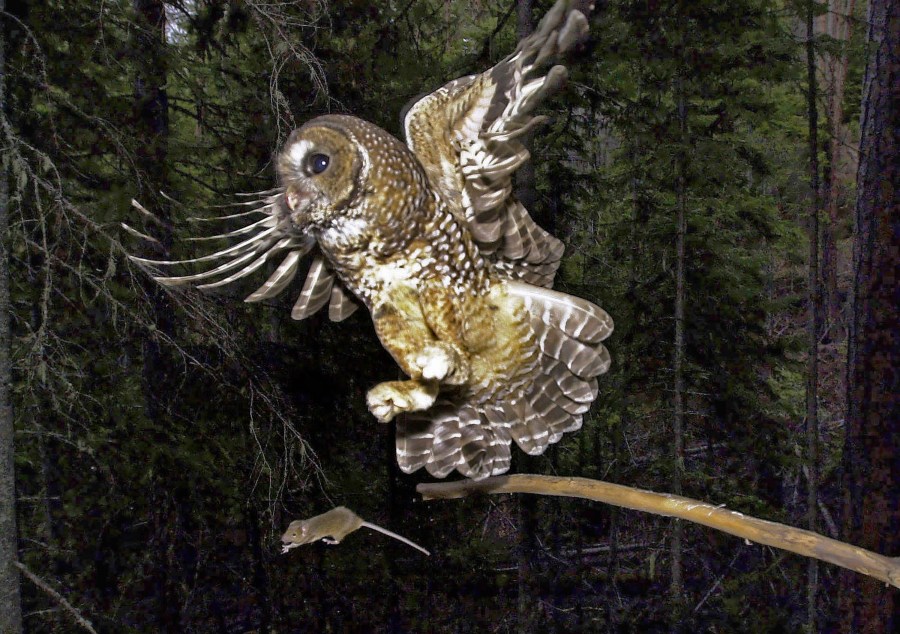PORTLAND, Ore. (KOIN) — A new study shows removals of the invasive barred owl populations helped arrest the population decline of the threatened northern spotted owl, whose decline is attributed to competition from the barred owl and the loss of old-growth forest habitats.
The 17-year study in Oregon, Washington and California is one of the largest field experiments ever done about birds of prey, according to its lead scientist, Dave Wiens, Research Wildlife Biologist with U.S. Geological Survey.
Wiens said the barred owl’s introduction to the region in recent years has increased competition with native spotted owls for old growth forest habitat and prey.
“The spotted owl populations are in trouble. Their populations are declining very quickly. And there are many reasons for that. But one of the main reasons is the invasion of the Pacific Northwest by barred owls, which is a closely related species to spotted owls,” Wiens said. “They out-compete spotted owls for territories and resources that are associated with those territories, like prey species.”
He added that the initial population declines of spotted owls were historically triggered by habitat loss. But those declines were then exacerbated by the introduction of barred owls, an invasive species that bears a resemblance to spotted owls and have been taking up residence in the Pacific Northwest in recent years, particularly in the last decade. The past 10 years is also the period of time when spotted owls saw a particularly steep decline.
The study was published in Proceedings of the National Academy of Sciences by scientists at USGS, Oregon State University and several other entities. It represents the first look at the wide-scale impact of barred owl population on spotted owls in the Pacific Northwest.

There were five total locations of the study: two sites in northern California, two in Oregon and one in Washington. Researchers found that all of the study areas where researchers lethally removed barred owls had spotted owl populations stabilize and in the areas where they left barred owls alone, spotted owl populations continued to sharply decline. Areas where barred owls were removed saw a 0.2% decline of spotted owl populations per year on average and areas where barred owls were left alone saw a 12.1% decline of spotted owl populations per year on average. It’s also important to note that barred owl removals did not ultimately result in population growth of spotted owls throughout the study areas, Wiens said.
“Barred owls are a new, top predator in the system that are feeding on a wide variety of native prey species out there, particularly amphibians. And so there’s a concern about how barred owls are affecting other species, beyond just spotted owls as well.”
Dave Wiens, Research Wildlife Biologist, U.S. Geological Survey
In terms of the “lethal removals” of barred owls, Wiens said that involved using shotguns to remove the birds. All of the some 2,500 barred owls that were removed in the study were then carefully collected as scientific specimens and distributed across the nation to universities and museums to be used for further scientific research. The barred owl is native to the east coast United States, are still considered widespread and common and not listed as endangered or threated under the Endangered Species Act.
The results from the barred owl removal study are now being used to develop the barred owl management strategy going forward for the U.S. Fish and Wildlife Service, an agency that worked closely with the scientists for the study in addition to tribal lands, Wiens said.
“It’s essentially holding steady. Almost at zero, right. And so yeah, it really illustrated the impact that barred owls are having on spotted owls, particularly in recent years.”
The conservation and restoration of old forests has been a chief focus of recovery strategies for spotted owls over the years, a major source of controversy in the Pacific Northwest.
The U.S. Fish and Wildlife Service listed the spotted owl as threatened under the Endangered Species Act in 1990 because of the rapid declines in the owl’s old-growth forest habitat. Thanks to the adoption of the Northwest Forest Plan in 1994, the rate of logging of old-growth forests on federal lands was greatly reduced, representing a major economic toll on the timber harvest industry.

Despite more than 30 years of protection, spotted owl populations continued to decline, with the steepest downturn happening in the last 10 years.
Wiens said the rapid decline of spotted owl populations in recent years, despite good management of federally protected habitat lands, is from the barred owl’s contribution to the issue. But he added it’s important to recognize the spotted owl’s decline is the result of a combination of issues compounding each other.
“It’s not just one thing or the other, it’s not barred owls or habitat, it’s a combination of these things,” Wiens said.
He added that some of the more recent, very large wildfires, particularly in western Oregon, have also had a big impact in terms of habitat loss for both spotted owls and barred owls.
“When you think about how these two species are competing for that habitat that is available, you can see how the competition increases as that habitat availability starts to decrease.”
Overall, the invasion of barred owls to the region may present larger problems outside the scope of just their impact on spotted owls, too.
“Barred owls are a new, top predator in the system that are feeding on a wide variety of native prey species out there, particularly amphibians. And so there’s a concern about how barred owls are affecting other species, beyond just spotted owls as well.”
The U.S. Fish and Wildlife Service also announced Monday that they are proposing to withdraw from a January 15, 2021 rule, under then President Donald Trump’s administration, that would have excluded 3.4 million acres of critical habitat for the northern spotted owl. The announcement is part of a larger effort by the administration of President Joe Biden to review or reverse environmental protection roll backs authorized under Trump.
USFWS said it is also simultaneously proposing a revised critical habitat rule for the spotted owl that identifies 204,797 acres of exclusions from the 2012 critical habitat designation under a subsection of the ESA.
The proposed exclusions are located in 15 Oregon counties in which 184,000 acres are on Bureau of Land Management-administered lands and 20,000 acres are on Tribal lands, USFWS said.
“The Service continues to work closely with federal, state and Tribal partners to use the best available science to evaluate conservation needs and implement actions that protect the owl,” said Martha Williams, Service Principle Deputy Director, in a prepared statement. “The exclusions we are proposing now will allow fuels management and sustainable timber harvesting to continue while supporting northern spotted owl recovery.”
Although USFWS did find the spotted owl’s uplisting from threatened to endangered under the ESA was warranted based on elevated threats from habitat loss and barred owl competition, the agency stopped short of officially making the change in designation. Back in December 2020, the service announced that the uplisting is warrant, but that it would not be taking on any new action items due to being precluded by higher priority actions, a position that remains unchanged.
USFWS is seeking public comment on the proposed revised critical habitat rule, which was published in the Federal Register on Tuesday, opening a 60-day public period that closes on September 20, 2021.
More information and a link to the proposed rule can be found on the service’s website.